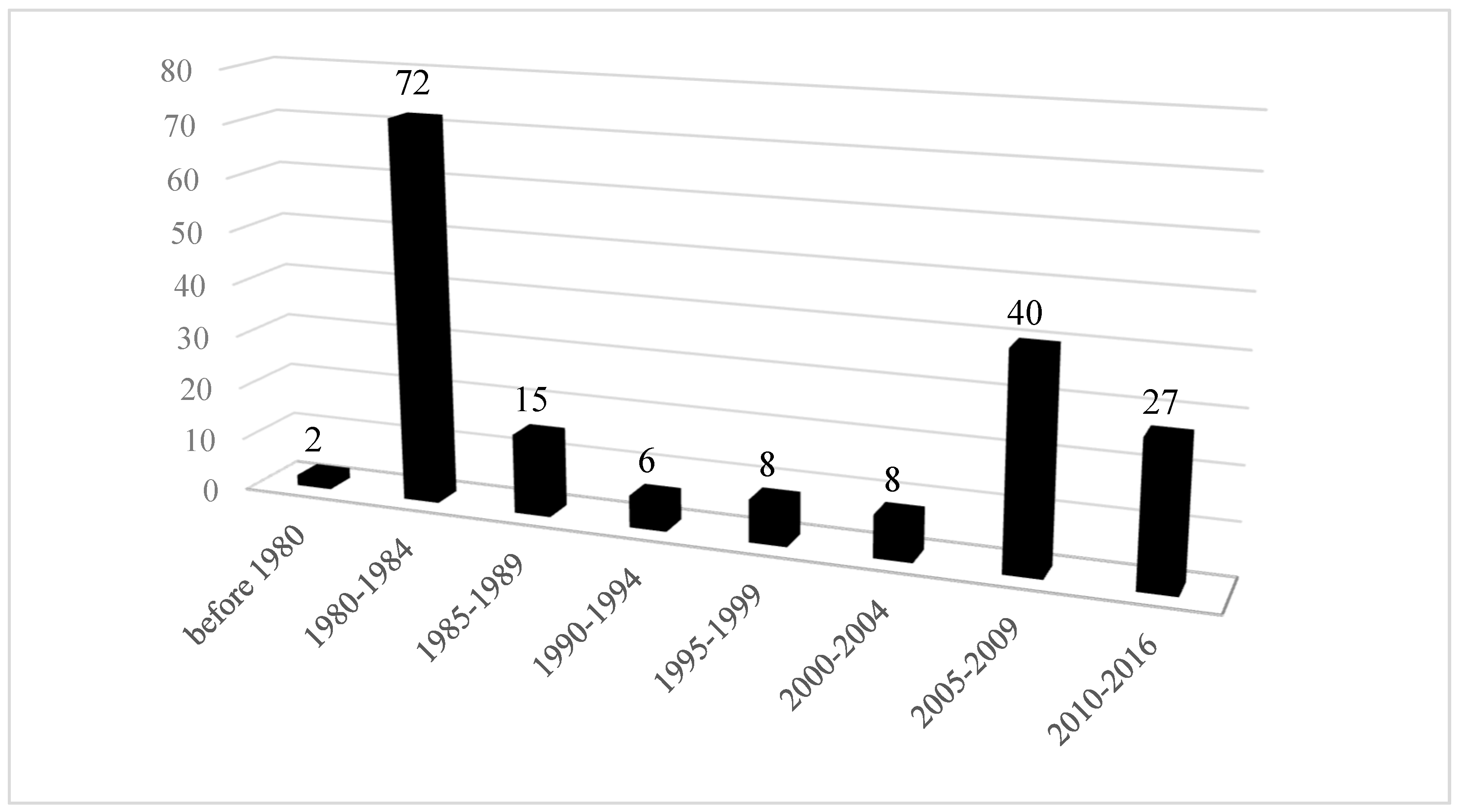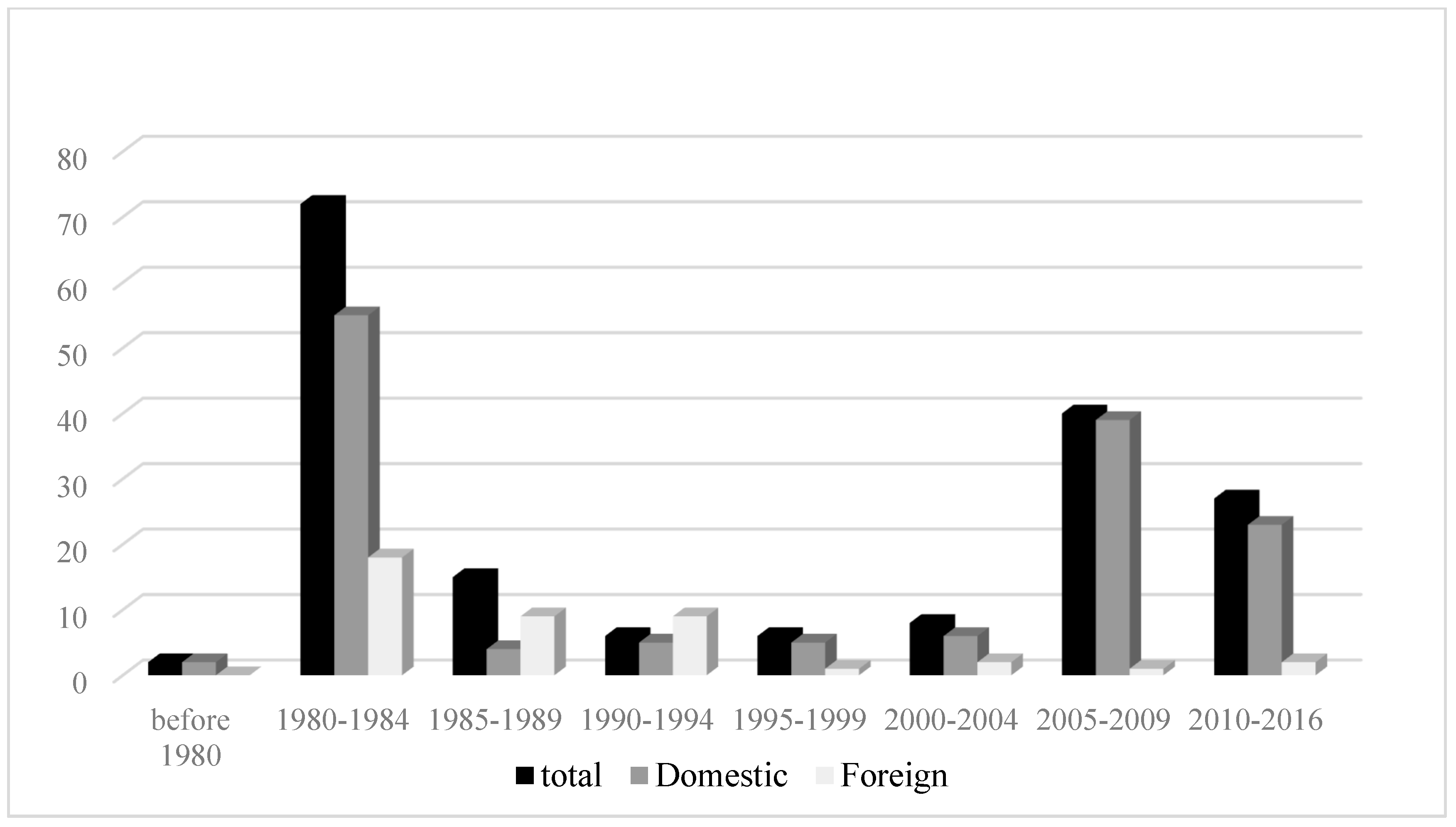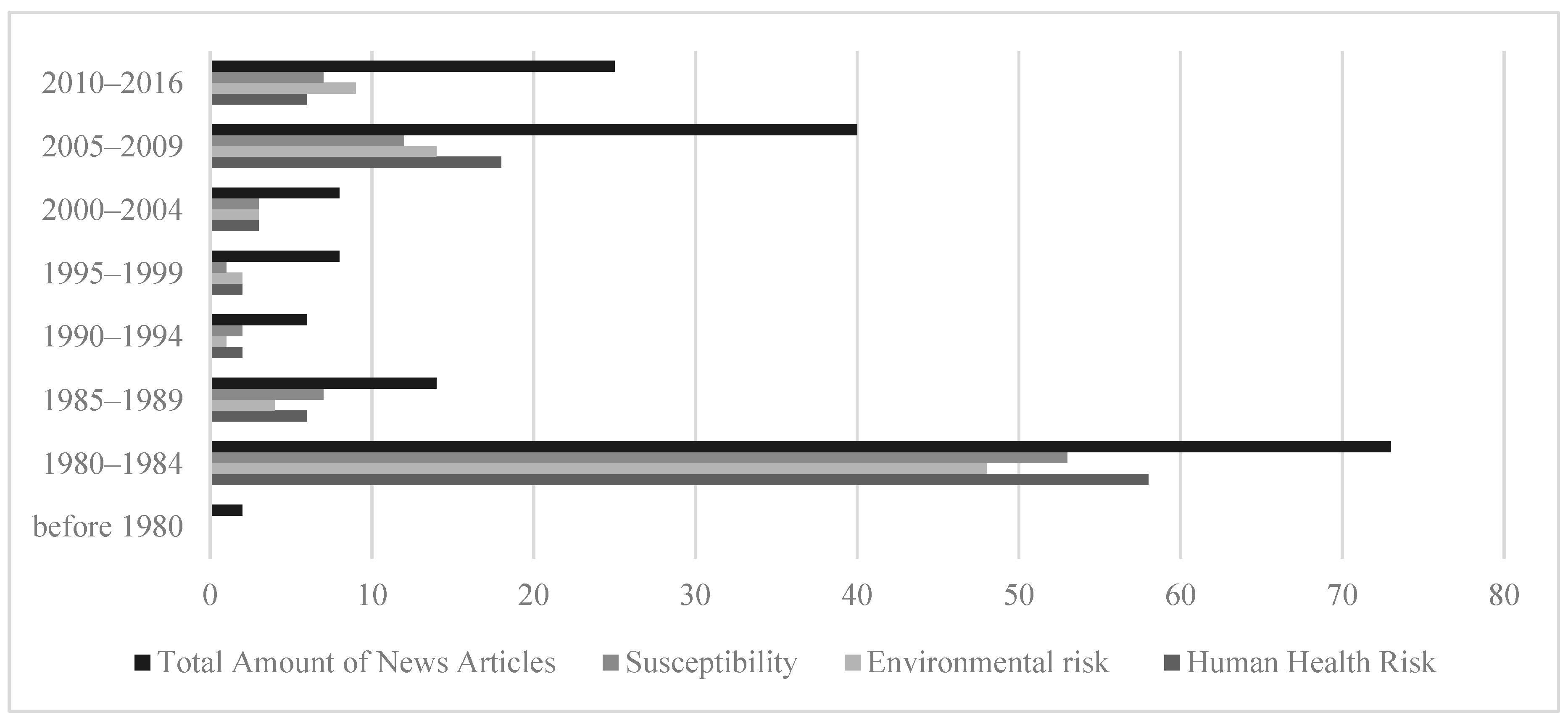Risk, Stigma, Trustworthiness, and Citizen Participation—A Multifaceted Analysis of Media Coverage of Dioxin Contamination in Midland, Michigan
Abstract
1. Introduction
1.1. Agenda-Setting Theory and Environmental Hazards
1.2. Context: Dioxins and Environmental Protection Agency (EPA) Areas of Concern
1.3. Research Questions
2. Method
2.1. Sampling
2.2. Codebook Development
2.2.1. Basic Information
2.2.2. Focal Features of News Coverage
2.3. Training, Intercoder Reliability, and Coding
3. Results
3.1. Preliminary Results
3.2. Research Questions
4. Discussion
5. Conclusions
Author Contributions
Funding
Conflicts of Interest
References
- Hansen, A. Communication, media and environment: Towards reconnecting research on the production, content and social implications of environmental communication. Int. Commun. Gaz. 2011, 73, 7–25. [Google Scholar] [CrossRef]
- Lazarsfeld, P.F.; Merton, R.K. Mass communication, popular taste and organized social action. In Media Studies: A Reader, 2nd ed.; Marris, P., Thornham, S., Eds.; New York University Press: New York, NY, USA, 1996; pp. 5–17. [Google Scholar]
- Iyengar, S. Television news and citizens’ explanations of national affairs. Am. Political Sci. Rev. 1987, 81, 815–831. [Google Scholar] [CrossRef]
- Kortenkamp, K.V.; Basten, B. Environmental science in the media: Effects of opposing viewpoints on risk and uncertaint perceptions. Sci. Commun. 2015, 37, 287–313. [Google Scholar] [CrossRef]
- Wang, N.; Guo, Z.; Shen, F. Message, perception, and Beijing Olympics: Impact of differential media exposure on perceived opinion diversity. Commun. Res. 2010, 38, 422–445. [Google Scholar] [CrossRef]
- Adams, B. Public meetings and the democratic process. Public Adm. Rev. 2004, 64, 43–54. [Google Scholar] [CrossRef]
- Keskitalo, E.C.H.; Wasterhoff, L.; Juhola, S. Agenda-setting on the environment: The development of climate change adaptation as an issue in European states. Environ. Policy Gov. 2012, 22, 381–394. [Google Scholar] [CrossRef]
- Kuttschreuter, M.; Gutteling, J.M.; de Hond, M. Framing and tone-of-voice of disaster media coverage: The aftermath of the Enschede fireworks disaster in the Netherlands. Health Risk Soc. 2011, 13, 201–220. [Google Scholar] [CrossRef]
- Jones, N. Environmental activation of citizens in the context of policy agenda formation and the influence of social capital. Soc. Sci. J. 2010, 47, 121–136. [Google Scholar] [CrossRef]
- McCombs, M.E.; Shaw, D. The agenda-setting function of mass media. Public Opin. Q. 1972, 69, 247–261. [Google Scholar] [CrossRef]
- Protess, D.; McCombs, M. Agenda Setting: Readings on Media, Public Opinion, and Policy Making; Routledge: New York, NY, USA, 2016. [Google Scholar]
- Dearing, J.W.; Roger, E.M. Communication Concepts II: Agenda-Setting; Sage Publications: Thousand Oaks, CA, USA, 1996. [Google Scholar]
- Wanta, W.; Ghanem, S. Effects of agenda setting. In Mass Media Effect Research: Advances through Meta-Analysis; Preiss, R.W., Gayle, B.M., Burrell, N., Allen, M., Bryant, J., Eds.; Routledge: New York, NY, USA, 2007. [Google Scholar]
- Bakir, V. Media and risk: Old and new research directions. J. Risk Res. 2010, 13, 5–18. [Google Scholar] [CrossRef]
- World Health Organization (WHO). Dioxins and Their Effects on Human Health. 2016. Available online: https://www.who.int/news-room/fact-sheets/detail/dioxins-and-their-effects-on-human-health (accessed on 18 October 2019).
- Powell, W. Remember Times Beach: The Dioxin Disaster, 30 Years Later. St. Louis Magzine. 2012. Available online: https://www.stlmag.com/Remember-Times-Beach-The-Dioxin-Disaster-30-Years-Later/ (accessed on 18 October 2019).
- White, S.S.; Birnbaum, L.S. An overview of the effects of dioxins and dioxin-like compounds on vertebrates, as documented in human and ecological epidemiology. J. Environ. Sci. Health C. Environ. Carcinog. Ecotoxicol. Rev. 2009, 27, 197–211. [Google Scholar] [CrossRef] [PubMed]
- Leistner, M. The Times Beach Story. Synthesis/Regeneration 7–8. 1995. Available online: http://www.greens.org/s-r/078/07-09.html (accessed on 18 October 2019).
- Garabrant, D.H.; Franzblau, A.; Lepkowski, J.; Gillespie, B.W.; Adriaens, P.; Demond, A.; Maier, M. The University of Michigan dioxin exposure study: Predictors of human serum dioxin concentrations in Midland and Saginaw, Michigan. Environ. Health Perspect. 2009, 117, 803–810. [Google Scholar] [CrossRef] [PubMed]
- United States Environmental Protection Agency. Dow to Clean up Dioxin Hot Spot in the Saginaw River; Environmental Protection Agency: Washington, DC, USA, 2007.
- Zhuang, J.; Cox, J.; Cruz, S.; Dearing, J.; Hamm, J.; Upham, B. Environmental stigma: Resident responses to living in a contaminated area. Am. Behav. Sci. 2016, 60, 1322–1341. [Google Scholar] [CrossRef]
- Slovic, P. Informing and educating the public about risk. Risk Anal. 1986, 6, 403–415. [Google Scholar] [CrossRef]
- Corbett, J.B.; Durfee, J.L. Testing public (un)certainty of science: Media representations of global warming. Sci. Commun. 2004, 26, 129–151. [Google Scholar] [CrossRef]
- Dixon, G.N.; Clarke, C.E. Heightening uncertainty around science: Media coverage, false balance, and the autism-vaccine controversy. Sci. Commun. 2012, 35, 358–382. [Google Scholar] [CrossRef]
- Jonsson, A.M. Framing environmental risks in the Baltic Sea: A news media analysis. Ambiology 2011, 40, 121–132. [Google Scholar] [CrossRef]
- Edelstein, M.R. Toward a Theory of Environmental Stigma. In Public Environments; Harvey, J., Henning, D., Eds.; Environmental Design Research Association: Ottawa, ON, USA, 1987; pp. 21–25. [Google Scholar]
- Satterfield, T.A. Risk, remediation and the stigma of a technological accident in an African-American community. Hum. Ecol. Rev. 2000, 7, 1–11. [Google Scholar]
- Stack, W.J.; Jacobson, T. Diminution in property value arising from the stigma of environmental contamination: A phantom injury in search of actual damages. Environ. Claims J. 1998, 11, 21–47. [Google Scholar] [CrossRef]
- Noonan, D.S.; Krupka, D.J.; Baden, B.M. Neighborhood dynamics and price effects of superfund site clean-up. J. Reg. Sci. 2007, 47, 665–692. [Google Scholar] [CrossRef][Green Version]
- Groshek, J.; Tandoc, E. The affordance effect: Gatekeeping and (non)reciprocal journalism on Twitter. Comput. Hum. Behav. 2017, 66, 201–210. [Google Scholar] [CrossRef]
- Skouloudis, A.; Jones, N.; Roumeliotis, S.; Issac, D.; Greig, A.; Evangelinos, K. Industrial pollution, spatial stigma, and economic decline: The case of Asopos river basin through the lens of local small business owners. J. Environ. Plan. Manag. 2017, 60, 1575–1600. [Google Scholar] [CrossRef]
- Flynn, J.; Peters, E.; Mertz, C.K.; Slovic, P. Risk, media, and stigma at rocky flats. Risk Anal. 1998, 18, 715–727. [Google Scholar] [CrossRef]
- Van Ooschot, W.; Arts, W.; Gelissen, J. Social capital in Europe: Measurement and social and regional distribution of a multifaceted phenomenon. Acta Sociol. 2006, 49, 149–167. [Google Scholar] [CrossRef]
- Lubell, M. Environmental activism as collective action. Environ. Behav. 2002, 34, 431–454. [Google Scholar] [CrossRef]
- Hamm, J.A.; Cox, J.G.; Zwickle, A.; Zhuang, J.; Cruz, S.M.; Upham, B.L.; Chung, M.; Dearing, J.W. Trust in whom? Dioxin, organizations, risk perception, and fish consumption in MichiganΓÇÖs Saginaw Bay watershed. J. Risk Res. 2018, 1–14. [Google Scholar] [CrossRef]
- Johnson, R.J.; Scicchitano, M.J. Uncertainty, risk, trust, and information: Public perceptions of environmental issues and willingness to take action. Public Stud. J. 2000, 28, 633–647. [Google Scholar] [CrossRef]
- Depoe, S.P.; Walicath, J.W.; Elsebeer, M.A. Communication and Public Participation in Environmental Decision Making; State University of New York Press: Albany, NY, USA, 2004. [Google Scholar]
- De Vreese, C.H.; Boomgaarden, H. News, political knowledge and participation: The differential effects of news media exposure on political knowledge and participation. Acta Politica 2006, 41, 317–341. [Google Scholar] [CrossRef]
- Ostrom, E. Governing the Commons: The Evolution of Institutions for Collective Action; Cambridge University Press: Cambridge, UK, 1990. [Google Scholar]
- Brulle, R.J.; Carmichael, J.; Jenkins, J.C. Shifting public opinion on climate change: An empirical assessment of factors influencing concern over climate change in the U.S., 2002–2010. Clim. Chang. 2012, 114, 169–188. [Google Scholar] [CrossRef]
- Rogers, E.M.; Dearing, J.W.; Chang, S. AIDS in the 1980s: The Agenda-Setting Process for a Public Issue; Association for Education in Journalism and Mass Communication: Columbia, SC, USA, 1991. [Google Scholar]
- Mazur, A.; Lee, J. Sounding the global alarm: Environmental issues in the US national news. Soc. Stud. Sci. 1995, 23, 681–720. [Google Scholar] [CrossRef]
- Entman, R.M. Framing bias: Media in the distribution of power. J. Commun. 2007, 57, 163–173. [Google Scholar] [CrossRef]
- Donsbach, W. Psychology of news decisions. Journalism 2004, 5, 131–157. [Google Scholar] [CrossRef]
- Laurian, L. Public participation in environmental decision making: Findings from communities facing toxic waste cleanup. J. Am. Plan. Assoc. 2004, 70, 53–65. [Google Scholar] [CrossRef]
- Reinau, D.; Meier, C.R.; Blumenthal, R.; Surber, C. Skin cancer prevention, tanning, and vitamin D: A content analysis of print media in Germany and Switzerland. Dermatology 2016, 232, 2–10. [Google Scholar] [CrossRef]
- Sawano, T.; Ozaki, A.; Hori, A.; Tsubokura, M. Combating “fake news” and social stigma after the Fukushima Daiichi nuclear power plant incident—The importance of accurate longitudinal clinical data. QJM Int. J. Med. 2019, 112, 479–481. [Google Scholar] [CrossRef]
- Hansen, A. The media and social construction of the environment. Media Cult. Soc. 1991, 13, 443–458. [Google Scholar] [CrossRef]
- Lacy, S.; Riffe, D.; Varouhakis, M. Where do Ohioans get their environmental news? Newsp. Res. J. 2007, 28, 70–84. [Google Scholar] [CrossRef]
- Major, A.M.; Atwood, L.E. Environmental risks in the news: Issues, sources, problems, and values. Public Underst. Sci. 2004, 13, 295–308. [Google Scholar] [CrossRef]
- McKenna, B. Dow Chemical’s knowledge factories: Action anthropology against Michigan’s company town culture. J. Appl. Anthropol. Policy Pract. 2009, 16, 39–50. [Google Scholar] [CrossRef][Green Version]
- Lowrie, K.; Greenberg, M.; Waishwell, L. Hazards, risk, and the press: A comparative analysis of newspaper coverage of nuclear and chemical weapons sites. Risk Health Saf. Environ. 2000, 11, 49–68. [Google Scholar]
- Kim, Y.; Chen, H.-T. Social media and online political participation: The mediating role of exposure to cross-cutting and like-minded perspectives. Telemat. Inform. 2016, 33, 320–330. [Google Scholar] [CrossRef]
- Brulport, A.; Le Corre, L.; Chagnon, M.-C. Chronic exposure of 2, 3, 7, 8-tetrachlorodibenzo-p-dioxin (TCDD) induces an obesogenic effect in C57BL/6J mice fed a high fat diet. Toxicology 2017, 390, 43–52. [Google Scholar] [CrossRef] [PubMed]
- Hayes, D.; Lawless, J.L. As local news goes, so goes citizen engagement: Media, knowledge, and participation in US house elections. J. Politics 2015, 77, 447–462. [Google Scholar] [CrossRef]
- Nisbet, M.C.; Scheufele, D.A.; Shanahan, J.; Moy, P.; Brossard, D. Knowledge, reservations, or promise? A media effects model for public perceptions of science and technology. Commun. Res. 2002, 29, 584–608. [Google Scholar] [CrossRef]
- Van der Linden, S. The social-psychological determinants of climate change risk perceptions: Towards a comprehensive model. J. Environ. Psychol. 2015, 41, 112–124. [Google Scholar] [CrossRef]
- Lopera, E.; Moreno, C. The uncertainties of climate change in Spanish daily newspaper: Content analysis of press coverage from 2000 to 2010. J. Sci. Commun. 2014, 13, 1–17. [Google Scholar] [CrossRef][Green Version]
- Wozniak, A.; Lȕck, J.; Wessler, H. Frames, stories, and images: The advantage of a multimodal approach in comparative media content research on climate change. Environ. Commun. 2015, 9, 469–490. [Google Scholar] [CrossRef]





© 2019 by the authors. Licensee MDPI, Basel, Switzerland. This article is an open access article distributed under the terms and conditions of the Creative Commons Attribution (CC BY) license (http://creativecommons.org/licenses/by/4.0/).
Share and Cite
Zhuang, J.; Cox, J.G.; Chung, M.; Hamm, J.A.; Zwickle, A.; Upham, B.L. Risk, Stigma, Trustworthiness, and Citizen Participation—A Multifaceted Analysis of Media Coverage of Dioxin Contamination in Midland, Michigan. Int. J. Environ. Res. Public Health 2019, 16, 4165. https://doi.org/10.3390/ijerph16214165
Zhuang J, Cox JG, Chung M, Hamm JA, Zwickle A, Upham BL. Risk, Stigma, Trustworthiness, and Citizen Participation—A Multifaceted Analysis of Media Coverage of Dioxin Contamination in Midland, Michigan. International Journal of Environmental Research and Public Health. 2019; 16(21):4165. https://doi.org/10.3390/ijerph16214165
Chicago/Turabian StyleZhuang, Jie, Jeffrey G. Cox, Minwoong Chung, Joseph A. Hamm, Adam Zwickle, and Brad L. Upham. 2019. "Risk, Stigma, Trustworthiness, and Citizen Participation—A Multifaceted Analysis of Media Coverage of Dioxin Contamination in Midland, Michigan" International Journal of Environmental Research and Public Health 16, no. 21: 4165. https://doi.org/10.3390/ijerph16214165
APA StyleZhuang, J., Cox, J. G., Chung, M., Hamm, J. A., Zwickle, A., & Upham, B. L. (2019). Risk, Stigma, Trustworthiness, and Citizen Participation—A Multifaceted Analysis of Media Coverage of Dioxin Contamination in Midland, Michigan. International Journal of Environmental Research and Public Health, 16(21), 4165. https://doi.org/10.3390/ijerph16214165




